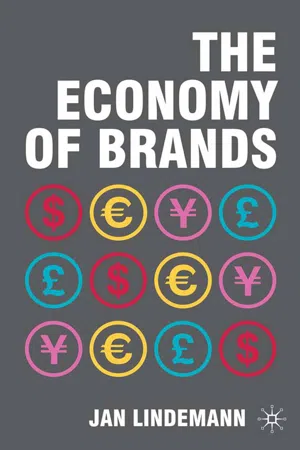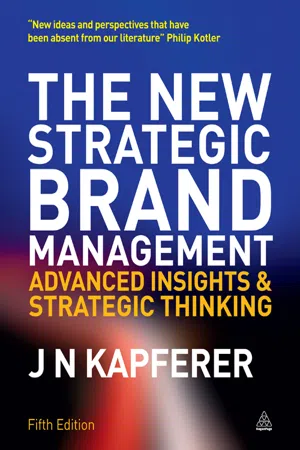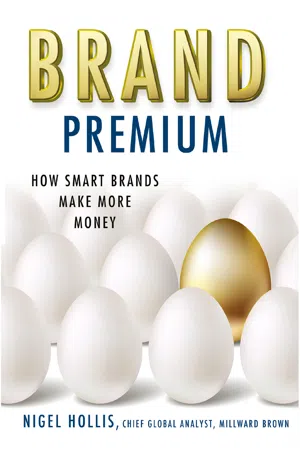Marketing
Brand value
Brand value refers to the perceived worth of a brand in the eyes of consumers. It encompasses the intangible aspects of a brand, such as its reputation, customer loyalty, and overall market position. A strong brand value can lead to increased customer trust, higher sales, and a competitive advantage in the market.
Written by Perlego with AI-assistance
Related key terms
1 of 5
10 Key excerpts on "Brand value"
- eBook - PDF
- J. Lindemann(Author)
- 2010(Publication Date)
- Palgrave Macmillan(Publisher)
CHAPTER 4 BRAND EQUITY: THE MARKETER’S VIEW ON Brand value At the time financial markets started recognizing the value of intangible assets and brands marketing academics in the US, in the early-1990s, also attempted to conceptualize the brand as a business asset. The result was the concept of brand equity which capitalized on a finan- cial term to define a marketing concept. The term was made popular by the publications of David Aaker and Kevin Keller. Aaker described brand equity as a “set of assets (and liabilities) linked to a brand’s name and symbol that adds to (or subtracts from) the value provided by a product or service to a firm and /or that firm’s customers.” 1 The main asset categories comprised awareness, loyalty, perceived quality, and other brand specific associations. Despite the use of the term equity, the framework consisted of a combination of market research metrics. Aaker later expanded the framework to include metrics from other mod- els, most notably Y&R’s brand asset evaluator and Interbrand’s brand strength assessment. The resulting measurement framework comprised the following metrics: 1. willingness to pay a price premium; 2. satisfaction/loyalty; 3. perceived quality; 4. leadership/popularity; 5. esteem/respect; 6. perceived value; 7. personality; 8. trust and admiration for the organization; 9. differentiation; 10. market share; 11. price differential; and 12. distribution depth/coverage. 23 T H E E C O N O M Y O F B R A N D S As the broad set of metrics suggests the framework is more a guid- ance for the issues and themes to consider than a clear quantitative model. Aaker acknowledged that while all these measures have diag- nostic value, management efforts should focus on a minimum of one to a maximum of four relevant metrics. Selecting the relevant metrics requires educated judgment. - eBook - ePub
The New Strategic Brand Management
Advanced Insights and Strategic Thinking
- Jean-Noël Kapferer(Author)
- 2012(Publication Date)
- Kogan Page(Publisher)
One is customer-based and focuses exclusively on the relationship customers have with the brand (from total indifference to attachment, loyalty, and willingness to buy and rebuy based on beliefs of superiority and evoked emotions). The other aims at producing measures in dollars, euros or yen. Both approaches have their own champions. It is the goal of this fifth edition of The New Strategic Brand Management to unify these two approaches. Customer-based definitions The financial approach measures Brand value by isolating the net additional cashflows created by the brand. These additional cashflows are the result of customers’ willingness to buy one brand more than its competitors’, even when another brand is cheaper. Why then do customers want to pay more? Because of the beliefs and bonds that are created over time in their minds through the marketing of the brand. In brief, customer equity is the preamble of financial equity. Brands have financial value because they have created assets in the minds and hearts of customers, distributors, prescribers, opinion leaders. These assets are brand awareness, beliefs of exclusivity and superiority of some valued benefit, and emotional bonding. This is what is expressed in the traditional definition of a brand: ‘a brand is a set of mental associations, held by the consumer, which add to the perceived value of a product or service’ (Keller, 1998). These associations should be unique (exclusivity), strong (saliency) and positive (desirable). This definition has two problems. First it focuses on the gain in perceived value brought by the brand. How do consumers’ evaluations of a car change when they know it is a Volkswagen, a Peugeot or a Toyota? In this definition the product itself is left out of the scope of the brand: ‘brand’ is the set of added perceptions. As a result brand management is seen as mostly a communication task. This is incorrect - eBook - ePub
Brand Transformation
Transforming Firm Performance by Disruptive, Pragmatic and Achievable Brand Strategy
- Keith Glanfield(Author)
- 2018(Publication Date)
- Routledge(Publisher)
Measuring “Brand value” is very different from “brand valuation.” Brand value quantifies, in financial terms, the market influence of a firm’s brand set over a time period. It financially quantifies brand cause and effect and is a useful exercise to undertake. It provides a financial number that calculates the “value” branding brings to a firm. An example is the Interbrand list of top 100 world leading brands. It ranks the “value” of the world’s leading 100 brands (Apple, McDonalds, KFC, IBM, etc.). Those that generate a large number are considered to be more leading and powerful than those with a smaller number. For major world leading brands, no doubt a firm’s position in the rankings, or even appearing on the list of top 100 brands, is regarded as a form of prestige and one of a number of sources used for investor relations and corporate public relations purposes. For much smaller firms, this information is “nice to have” and important in establishing a business case and justification for a firm to appropriately invest in branding. Again what is important in day-to-day management terms are the factors that influence the “value” branding brings to a firm. Central to this is branding’s influence on consumers and what elements positively influence customer choice and loyalty. To measure and assess this, firms and their marketers need to turn to brand strength, or what is commonly termed “brand equity.”Brand equity is the quantification and measurement of a brand’s overall strength. It measures the influence of brands with consumers. Brand equity does not put a financial value against a brand but instead determines, from a consumer point of view, what aspects of a brand work well and not so well. A number of alternative perspectives are taken to measuring brand equity. They range from measuring a brand’s incremental influence on consumer’s response to marketing communications activity on to assessing the incremental contribution branding makes to consumer preference for a given product or service. In broad terms, brand equity comprises brand loyalty, perceived quality, brand awareness and brand associations, measuring the influence of each on consumer brand preference. Understanding the market and consumer influence of branding, relative to a firm’s competitors, is extremely important for a firm to measure and understand. It is the foundation of “brand valuation” and “Brand value” and forms the essential set of measures a firm needs to develop to fundamentally understand the performance of its brands.In summary, “brand valuation” puts a valuation to brands as an intangible asset. This is more of a concern for finance professionals than marketers and is not, therefore, considered to be of further relevance in this book (see ISO 10668 for more information). However, “Brand value” and “brand equity” are both of interest to marketers and firms alike. The former establishes the financial contribution branding delivers to a firm. The latter is a measure of branding performance from a consumer perspective. Both potentially drive important outcomes for a firm and its investors, including margin or net profit (earnings before interest and taxation), cash flow and dividend yields. It is, therefore, important to understand the composition of each and their relative influence on a firm’s performance. - eBook - PDF
Competitive Success
How Branding Adds Value
- John A. Davis(Author)
- 2014(Publication Date)
- Wiley(Publisher)
As we will see there are differences in methodologies and philosophies. This complicates the pursuit of Brand value measurement. This book emphasizes the practices that help companies create strong brands and build sustainable value. In this chapter, we introduce ways to assess and meas- ure Brand value. Knowing how to measure a brand’ s value is vital to companies seeking ways to justify their investments in marketing activities. David Haigh, CEO of BrandFinance, a leading brand consultancy states, “63% of enterprise value is intangible.” 1 David Haigh ’ s comment highlights the increasingly important role that intan- gible assets have in the total value of the firm. No longer is it sufficient to ascribe such unexplained value as goodwill on the balance sheet. Accounting rules for valuing intangibles have been updated around the world over the years, placing added importance on properly assessing their worth. This discussion is of para- mount importance to brand building because management’ s strategic decisions will have a profound impact on corresponding organizational activities in support of growing the brand that, in turn, will affect intangible value. Brand Equity and Brand value Revisited To begin, a point of clarification is in order. A minor controversy, or perhaps more accurately confusion, exists about the difference between brand equity and Brand value. It is understandable given the profusion of theories and books offering alternative explana- tions. For the purposes of clarity, they are defined as follows: Brand equity describes stakeholder response in the form of an increase in customers, revenues, and margins than would otherwise be possible without marketing support to build awareness. Brand value represents the total value of the brand. As one can readily surmise, complications still arise as there are numerous ways to inter- pret how best to measure Brand value. - eBook - PDF
- John M. T. Balmer, Shaun M. Powell, Joachim Kernstock, Tim Oliver Brexendorf, John M. T. Balmer, Shaun M. Powell, Joachim Kernstock, Tim Oliver Brexendorf(Authors)
- 2016(Publication Date)
- Palgrave Macmillan(Publisher)
Thus, when considering Brand value, it is necessary to focus on long-term Brand value and the sources of that value, rather than the here-and-now value of the brand. Doyle 34 (p. 21) is right in stating that ‘Top managers nowadays do not hold their jobs long if they do not increase the financial value of the firm. Strong brands, customer awareness, market share and satisfied cus- tomers are not goals in their own right, but means to create shareholder value.’ The development and survival of the brand (and the creation of shareholder value) is, however, dependent on an understanding of the value the brand creates for its stakeholders and the (often turbulent) context within which the brand exists. Thus Brand value must concern itself with looking at the sources of the creation and co-creation of value for both the firm and its stakeholders. Once an understanding of Brand value is achieved, then specific measures of this value can be examined. Brand equity is used to define the value of the brand. Its specific definition, however, varies considerably in the literature. The most com- mon approach to brand equity is as a measure of customer franchise, 35 that is, the value of the brand from the point of view of the customer and the long-term financial consequences of this for the company. Broadly, the existing literature can be divided into three categories: 36 mental brand equity, that is, the impact of the brand on the consumer’s 124 Richard Jones consciousness; behavioural brand equity, that is, the consumer’s behav- ioural response to the brand (or that which can be directly attributable to the brand); and, thirdly, financial equity, that is, the financial impact of the brand as expressed through return on investment, profit, turnover, price-to-earnings ratio etc. - eBook - PDF
Asian Brand Strategy
How Asia Builds Strong Brands
- M. Roll(Author)
- 2005(Publication Date)
- Palgrave Macmillan(Publisher)
13 CHAPTER 2 BRANDING – THE DRIVER OF A SUCCESSFUL BUSINESS STRATEGY The way we made money in the past was by saving money, by cutting costs. Now we have to make money by spending money, by investing in our brand. 1 Eric Yu, CFO, BenQ Today, businesses and consumers are placing increasing importance on brands. Brands give consumers a sense of identity, stimulate their senses and enrich their life experiences. People have a need to affiliate and surround themselves with things they know well, trust and aspire to be. From a customer viewpoint, a brand is a signal of quality and creates a bond of trust with the manufacturers behind them. TABLE 2.1 Nine characteristics of a strong brand 1. A brand drives shareholder value 2. The brand is led by the boardroom and managed by brand marketers with an active buy-in from all stakeholders 3. The brand is a fully integrated part of the entire organization, aligned around multiple touch points 4. The brand can be valued in financial terms and must reside on the asset side of the balance sheet 5. The brand can used as collateral for financial loans and can be bought and sold as an asset 6. Customers are willing to pay a substantial and consistent price premium for the brand versus a competing product and service 7. Customers associate themselves strongly with the brand, its attributes, values and personality, and fully buy into the concept which is often characterized by an emotional and intangible relationship (higher customer loyalty) 8. Customers are loyal to the brand and would actively seek it and buy it despite several other reasonable and often cheaper options available (higher customer retention rate) 9. A brand is a trademark and marque (logo, shape, color and so on) which is fiercely and proactively protected by the company and its legal advisors Source: VentureRepublic Psychological research demonstrates that brands are durable because people are cognitive misers. - eBook - PDF
Raising the Corporate Umbrella
Corporate Communications in the Twenty-First Century
- Philip J. Kitchen, Don E. Schultz(Authors)
- 2001(Publication Date)
- Palgrave Macmillan(Publisher)
341 Chapter Measuring the value of the corporate brand don e. schultz 13 Managing a Major Corporate Asset What is the value of the corporate brand? How much actual financial worth does it comprise? If we could strip out the value of the corporate brand from all the other corporate assets, both tangible and intangible, would this be a relevant or negligible amount for the firm? The problem is, most managers and most organizations don’t know.And, because they don’t know the brand’s value, they are generally unable to answer the three basic ques- tions posed at the end of Chapter 12. ■ How much should the firm invest in building and maintaining its corporate brand? ■ What type of financial return will the organization receive as a result of those investments? ■ Over what period of time will those results occur if they occur at all? Because the managers of the organization don’t know the financial value of what might be one of its most valuable assets, the common tendency is to either over-invest or under-invest in building and maintaining that Brand value or equity. Or, perhaps the worst case of all, is that the corporate brand receives no attention or action simply because its value is unknown or unrec- ognized.As seen in Chapter 11 and elsewhere, this means essentially that they have passed all control of image into the hands of their stakeholders. An example will help illustrate the point. (Note:The illustration below is true but the names and figures have been disguised to avoid proprietary values being disclosed.) Over the past few years, a London-based consultancy, Interbrand, has conducted a number of Brand value studies. Based on those studies, they have ILLUSTRATION 342 R A I S I N G T H E C O R P O R AT E U M B R E L L A been able to develop a series of “rules of thumb” or “norms” about the finan- cial value of the brand or brands to an organization in various industry cat- egories in comparison to their other assets. - eBook - PDF
Pharmaceuticals-Where's the Brand Logic?
Branding Lessons and Strategy
- Giles David Moss(Author)
- 2016(Publication Date)
- CRC Press(Publisher)
All rights reserved. doi: 10. I300/5836-02 19 mind of consumers as a set of tangible (rational) and intangible (irrational) benefit^.^ A brand “is the aura that surrounds a product or service that communicates its benefits and differentiates it from the compe- tition for the con~umer.”~ Brand management is a process that requires resources and fo- cus from all functions, within a company, to succeed in one stra- tegic intent-creating a difference. The fundamental task is to transform the product category.s 9 “Brand equity is a set of assets (and liabilities) linked to a brand’s name and symbol that adds to (or subtracts from) the value pro- vided by a product or service to a firm and/or that firm’s custom- ers.” The major asset categories being brand name awareness, brand loyalty, perceived quality, and brand associations.”6 Given that there is general confusion concerning branding, even in the fast moving consumer goods (FMCG) area, there is little real sur- prise that an industry dominated by mass sales forces, multiple cus- tomers, patent defense lawyers, and huge R&D organizations is going to find branding difficult to pin down. The brand concept, as indicated in the above definitions, goes beyond the product concept. A product delivers certain tangible benefits. A brand offers additional values that are both tangible and intangible, adding emotion to rational choice. A brand can be considered as the added value of marketing investments made in a certain product. The Mercedes brand, for example, is registered in the minds of con- sumers as a brand offering a set of tangible benefits (solidity, reliabil- ity, and Germanic quality) and intangible benefits (success, status), linked to what the brand represents. Some brands focus more on tangi- ble benefits (Volvo, Gillette, and Pampers) while others more on in- tangible benefits (Coca-Cola, Perrier, and Marlboro) dependant on their market. All have managed to create strong associations in the consumer’s mind. - eBook - PDF
Brand Premium
How Smart Brands Make More Money
- N. Hollis(Author)
- 2017(Publication Date)
- Palgrave Macmillan(Publisher)
into people’s lives? Make sure the brand is present when and where people might want to encounter it. While specific communication strategies may differ, ensure the brand conveys the same essence across all touch points. Questions to Consider 171 Chapter 13 Affordability at a Price Point Apart from the quality of the product or service, affordability is the most important variable in the marketing mix. Finding ways to make it easier for people to buy your brand will help entice new buyers, but if the balance between price and value perceptions is off, then the brand will end up los- ing margin and enter a death spiral. As a brand’s income declines, funds for research and development and marketing are choked off, reliance on price promotion to drive volume grows, and the brand becomes uncompetitive. To avoid this demise, you need to make the brand more affordable—not simply cheaper. A savvy marketer will be able to manipulate people’s per- ceptions of value in order to maximize the income stream from a brand at a specific price point or find ways to make the brand more affordable without lowering margins. PRICE DECREASES AND VOLUME SALES A few years ago, I conducted an analysis based on a set of 354 consumer packaged goods brands for which we had volume and value market share data across the course of two sequential years. Volume market share is the number of units sold by each brand divided by the overall category sales. Value market share is the dollar sales of each brand divided by the overall category dollar sales. The brands in this analysis came from a wide vari- ety of categories and countries, with data being sourced from our clients or directly from sales measurement companies. From the two types of market share data we were able to derive another important measure: the relative price index. If you divide a brand’s value market share by its volume market share, you get a measure of price relative to the category average. - eBook - ePub
- Jay Gronlund(Author)
- 2013(Publication Date)
- Business Expert Press(Publisher)
There is no emotional driver more important for building a sustained relationship with target customers than the feeling of trust. So many variables are at play for determining the trust for a brand—confidence, integrity, reliability, credibility, the level of certainty, etc. The annual Edelman Trust Index survey shows that the level of trust for brands and business leaders has declined significantly in recent years. While the economic and pricing values for B2B decision making will always be vital, the increasing complexity of their buying process has caused the subjective value of trust to become even more crucial.This growing lack of trust is particularly evident among the emerging millennial segment (those born after 1980). A recent survey of 400 millennials by a marketing consulting firm, Social Chorus, showed a serious distrust level for brand advertising—only 6% consider online advertising to be credible (probably worse for traditional advertising), whereas feedback from their peers is the most influential for their purchase decisions (95% say their friends are the most credible source of information). A sense of trust for this emerging powerhouse group is essential: 92% say “trust” plays a key role on who influences them online.Another area where brand trust is becoming more critical is cross-cultural relationships. Every foreign market has different business practices and a unique culture, so it is natural to be suspicious and distrustful of any new venture from the outside. Companies must recognize these barriers, and working with local managers, conduct insightful research to better understand their special emotional drivers and create new ideas for relevant marketing initiatives that would appeal to their cultural passions.The intangible value of a brand trust and/or a company reputation is a significant contributor of a company's valuation as well. Other sources of intangible value are a company or brand's market position, its business systems (proprietary software, processes, etc.) and its knowledge (R&D, patents, human capital, etc.). In their book The Brand Bubble
Index pages curate the most relevant extracts from our library of academic textbooks. They’ve been created using an in-house natural language model (NLM), each adding context and meaning to key research topics.









